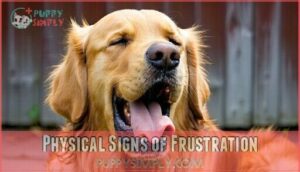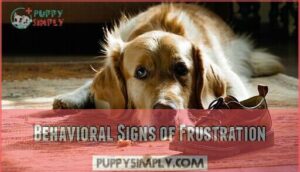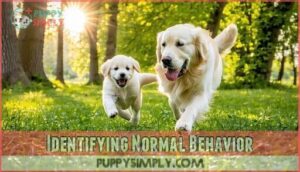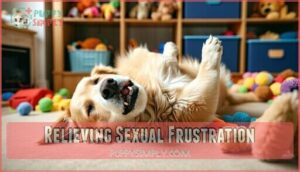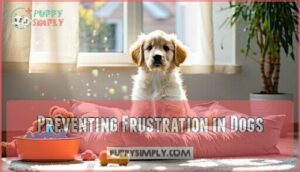This site is supported by our readers. We may earn a commission, at no cost to you, if you purchase through links.
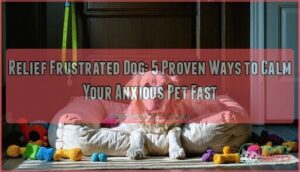 When you need relief frustrated dog solutions, start with exercise and mental stimulation.
When you need relief frustrated dog solutions, start with exercise and mental stimulation.
A tired dog is typically a calmer dog.
Remove triggers that spark frustration, like barking at windows or other pets.
Create consistent routines so your pup knows what to expect.
Use positive reinforcement when they stay calm instead of acting out.
Sometimes frustration stems from pent-up energy or boredom, so puzzle toys work wonders.
If your dog’s pacing, whining, or showing destructive behavior, they’re telling you something’s wrong.
Quick fixes help, but understanding the root cause makes all the difference in long-term success.
Table Of Contents
- Key Takeaways
- Recognizing Frustrated Dogs
- Managing Frustration in Dogs
- Reducing Stress in Dogs
- Relieving Sexual Frustration
- Preventing Frustration in Dogs
- Frequently Asked Questions (FAQs)
- What are the long-term effects of neutering a dog?
- How can I help my dog cope with anxiety in public places?
- Which types of chew toys are best for my dog?
- How can I tell if my dog is feeling stressed?
- How long does dog frustration typically last?
- Can puppies experience frustration like adult dogs?
- Do certain dog breeds get frustrated more easily?
- Whats the difference between frustration and aggression?
- Can multiple dogs increase household frustration levels?
- Conclusion
Key Takeaways
- Increase exercise and mental stimulation – A tired dog is a calmer dog, so provide daily physical activity and puzzle toys to burn excess energy that fuels frustration and destructive behaviors.
- Create consistent routines and remove triggers – Establish predictable schedules for meals, walks, and rest while eliminating stressors like noise or visual triggers that spark your dog’s anxious reactions.
- Use positive reinforcement and redirection – Reward calm behavior immediately and redirect frustrated energy into constructive activities rather than punishing negative actions.
- Recognize the signs early and address root causes – Watch for pacing, excessive panting, whining, and destructive chewing, then work with your vet to rule out medical issues or consider behavioral training for long-term solutions.
Recognizing Frustrated Dogs
You’ll notice your dog’s frustration through clear physical signs like pacing, excessive panting, and restless behavior even when they haven’t exercised.
Watch for behavioral changes such as whining, destructive chewing, or inability to settle down, as these signals tell you your pet needs help managing their stress.
You can identify these signs to provide the necessary support for your dog’s well-being by recognizing the physical signs.
Physical Signs of Frustration
Your dog’s body language speaks volumes when stress hits.
Your dog’s eyes, ears, and posture reveal their inner emotional state before they even make a sound.
Watch for these telltale frustrated dog behavior signs that signal your pup needs help:
- Panting heavily without exercise or heat exposure
- Excessive licking of paws, legs, or surfaces as self-soothing
- Increased shedding in stressful situations or new environments
- Dilated pupils with rapid blinking and pinned-back ears
These dog frustration signs require immediate attention.
Behavioral Signs of Frustration
Beyond physical symptoms, your dog’s actions tell the real story.
Pacing and circling become their go-to coping mechanism when anxiety peaks.
You’ll notice excessive licking of paws or furniture, plus destructive behavior like chewed shoes or torn cushions.
Restlessness signs include constant position changes and inability to settle.
Vocal expressions escalate too—whining, barking, and whimpering become their frustrated dog behavior soundtrack when life feels overwhelming and they exhibit destructive behavior.
Identifying Normal Behavior
Understanding your dog’s baseline behaviors helps you spot when something’s off.
Normal behavior varies substantially due to breed differences, age variations, and individual temperament.
A Border Collie’s energy differs from a Bulldog’s calm nature.
Environmental influence shapes daily patterns too.
Young puppies naturally show more excitement than senior dogs.
Recognizing these normal canine behavior patterns makes identifying actual dog frustration much easier for concerned owners.
Dogs also possess a high degree of emotional intelligence, allowing them to perceive human emotions, which is key to understanding their emotional intelligence and canine behavior.
Managing Frustration in Dogs
Once you’ve spotted the signs of frustration in your dog, you can take specific steps to help them feel better.
The key is to give your dog healthy ways to release their pent-up energy while teaching them how to stay calm when things don’t go their way.
Exercise and Mental Stimulation
A tired dog is often a happy dog. Regular exercise burns excess energy that fuels dog frustration, while mental stimulation challenges your pet’s mind.
Mix up your Exercise Variety with walks, fetch, and Training Games. Puzzle Toys provide mental enrichment when you’re busy.
Some owners find interactive treat dispensers are helpful for anxious dogs. Consider your dog’s Breed Needs – some require more activity than others.
Daily dog mental stimulation prevents behavioral problems effectively.
Redirecting and Reinforcing Behaviors
When your pup shows frustration signals, redirect their energy into positive actions. Positive interruption works better than punishment – catch them before they spiral.
Guide them toward alternative activities that channel their drive constructively. Consider using interactive treat-dispensing toys to keep your dog mentally stimulated.
- Reward calmness immediately when your dog settles after redirections
- Offer puzzle toys as alternative activities during high-stress moments
- Practice "wait" commands for shaping behavior and impulse control
- Redirect mounting or pacing into structured play sessions
- Ignore attention-seeking frustration while rewarding quiet behavior
Creating a Calm Environment
Creating a calm environment starts with establishing a designated safe space where your dog can retreat when overwhelmed.
Use sound masking like soft music to muffle trigger noises, and introduce calming scents such as lavender.
Provide comfortable bedding in a quiet corner and reduce clutter around their area.
This harmonious environment, combined with consistent routine and positive reinforcement, helps your dog develop natural relaxation techniques.
Reducing Stress in Dogs
You can reduce your dog’s stress by removing triggers from their environment and teaching simple relaxation commands.
Working with your vet helps identify if your dog needs medication or has health issues causing their anxiety.
Removing Stressors and Triggers
After addressing physical and mental needs, focus on stress reduction by eliminating what’s making your dog anxious.
Environmental changes can work wonders for creating a calm environment.
Start by observing your dog’s reactions to identify triggers that cause distress.
- Noise Reduction: Use white noise machines or soft music to mask startling sounds
- Safe Spaces: Create quiet retreat areas with comfortable bedding away from household chaos
- Routine Consistency: Maintain predictable schedules for meals, walks, and rest times
Training and Commands for Relaxation
Teaching specific commands transforms anxious energy into focused calm.
Start with Mat Training—place your dog on a designated spot and reward stillness. Practice the Settle Command daily, using treats when they lie down quietly.
Implement Relaxation Protocol exercises that build Impulse Control gradually. These dog calming techniques create structure, helping your pet recognize Calming Signals and develop reliable dog relaxation methods for lasting dog frustration relief.
Veterinary Evaluation and Medication
When your dog’s frustration persists despite your best efforts, it’s time for veterinary consultation.
A thorough behavioral assessment helps identify underlying conditions that might be causing the stress. Your vet can determine if pain management or medication options could provide dog anxiety relief under veterinary supervision.
Modern veterinary practices recognize the importance of pet behavior management.
- Professional evaluation reveals hidden medical triggers behind behavioral issues
- Targeted dog medication can transform your pet’s quality of life dramatically
- Expert guidance guarantees safe, effective treatment matched to your dog’s needs
- Early veterinary attention prevents minor frustrations from becoming major problems
Relieving Sexual Frustration
When your dog shows signs like excessive whining, restless pacing, or mounting behaviors, sexual frustration might be the cause.
You can manage this common issue through simple separation techniques, distractions, and long-term solutions that restore your pet’s calm behavior.
Separation and Distraction Techniques
When sexual frustration peaks, dog separation from triggers becomes your first line of defense.
Remove your male dog from females in heat immediately.
Create safe spaces away from enticing scents using air purifiers or fans.
Distraction Strategy
Implementation
—
Puzzle toys
Brain games
Scent work
Mental stimulation through gradual desensitization helps manage separation anxiety effectively.
Many dogs experience stress and anxiety when left alone.
Neutering and Its Effects
Many owners consider neutering to address dog sexual frustration, but it’s not always the quick fix you’d expect.
Behavioral changes after spaying or neutering can include increased anxiety and fear-related responses.
Health implications extend beyond reproduction, potentially affecting metabolism and stress levels.
The neutering age matters – early procedures may impact development.
Recovery process requires patience, and ethical considerations include weighing benefits against potential psychological effects.
Some studies indicate that neutered dogs may exhibit increased resource guarding.
Managing Excitement in Female Dogs
During your dog’s heat cycle, restlessness and mounting behaviors signal sexual excitement.
Spaying offers long-term relief but carries surgical risks worth discussing with your vet.
Meanwhile, increase exercise needs to burn excess energy.
Use calming techniques like puzzle toys and mental stimulation.
Some breeds show stronger predispositions to reproductive behaviors.
Separate her from male dogs and maintain consistent routines during this challenging period.
Preventing Frustration in Dogs
You can stop frustration before it starts by building the right habits and environment for your dog.
Prevention works better than trying to fix problems after they happen, and it keeps your pet calmer and happier every day.
Establishing Consistent Routines
Dogs thrive on predictable schedules that reduce anxiety and build frustration tolerance.
Set consistent feeding times, walk consistency, and sleep patterns daily. Your pup’s internal clock craves playtime regularity and routine structure.
Managing dog frustration becomes easier when mealtimes happen at 7 AM and 6 PM every day. Dog calm routines create security, helping anxious pets anticipate what’s next instead of guessing.
To further promote relaxation, consider incorporating positive reinforcement methods into these routines, which can help with frustration tolerance.
Providing Appropriate Toys and Stimulation
Beyond routines, appropriate toys and mental stimulation keep your dog’s mind occupied.
Toy rotation prevents boredom while puzzle difficulty should match your dog’s skill level. Interactive games and breed-specific toys provide targeted enrichment activities.
Safe chews satisfy natural urges, and dog brain games challenge problem-solving abilities. Many owners find success with stimulating puzzle options.
These dog enrichment activities create positive outlets for energy, reducing frustration before it builds, and are a key part of dog brain games, puzzle difficulty, mental stimulation, and targeted enrichment.
Teaching Impulse Control and Regulation
Teaching your dog impulse control and regulation techniques builds their frustration tolerance over time.
Start with simple patience exercises like making them wait before meals or toys. Practice "stay" commands and gradually increase duration.
Use calming techniques during training sessions to help your dog learn emotional regulation. These impulse training methods teach your dog to pause, think, and respond calmly instead of reacting impulsively to triggers.
Frequently Asked Questions (FAQs)
What are the long-term effects of neutering a dog?
Cutting to the chase, neutering typically reduces sexual behaviors and aggression while potentially increasing weight gain.
You’ll see calmer temperament, decreased roaming, but possible joint issues if done too early.
Consult your vet for timing.
How can I help my dog cope with anxiety in public places?
Start with short visits to quiet public spaces.
Bring high-value treats and create positive associations. Practice basic commands beforehand.
Stay calm yourself—your energy affects them. Gradually increase exposure time as they become more comfortable, with high-value treats and positive associations.
Which types of chew toys are best for my dog?
Don’t bite off more than you can chew when selecting toys.
Choose rubber Kong toys for heavy chewers, rope toys for moderate chewers, and softer plush options for gentle dogs to match their chewing intensity.
How can I tell if my dog is feeling stressed?
Watch for pacing, excessive panting, destructive chewing, whining, or hiding behaviors.
Your dog’s ears might pin back, pupils dilate, or they’ll shed more than usual.
These signs often appear during routine changes or overstimulation.
How long does dog frustration typically last?
Dog frustration duration varies widely depending on the trigger and your dog’s temperament.
Acute episodes may last minutes to hours, while chronic frustration can persist for days or weeks without proper management and intervention.
Can puppies experience frustration like adult dogs?
Yes, puppies absolutely experience frustration just like adult dogs.
They’re actually more prone to it because they haven’t learned impulse control yet.
You’ll see whining, destructive chewing, and restless pacing when they can’t get what they want, which is a clear sign of frustration.
Do certain dog breeds get frustrated more easily?
Different strokes for different folks – some breeds are naturally more high-strung.
Working breeds like Border Collies and German Shepherds tend to get frustrated easier when they’re understimulated, while laid-back breeds stay calmer.
Whats the difference between frustration and aggression?
Frustration is your dog’s emotional response to blocked goals, while aggression is the behavioral action that might follow.
Think of frustration as the feeling and aggression as the potential reaction to that feeling.
Can multiple dogs increase household frustration levels?
Multiple dogs can definitely amp up household frustration levels.
You’ll face resource competition, territorial disputes, and pack dynamics that create tension.
Each dog’s individual stress compounds, making management more challenging and potentially triggering reactive behaviors.
Conclusion
Managing your canine companion’s emotional turbulence doesn’t have to feel overwhelming.
These relief frustrated dog strategies work best when you’re consistent and patient with the process.
Remember that every dog responds differently, so what works for one might need adjustment for another.
Start with exercise and mental stimulation, then gradually introduce other techniques.
Your furry friend’s behavior will improve with time, creating a more peaceful home environment for everyone involved.
- https://www.mdpi.com/2813-9372/1/1/7
- https://www.merckvetmanual.com/behavior/normal-social-behavior-and-behavioral-problems-of-domestic-animals/behavioral-problems-of-dogs
- https://www.researchgate.net/publication/248336444_A_note_on_the_effectiveness_of_behavioural_rehabilitation_for_reducing_inter-dog_aggression_in_shelter_dogs
- https://www.frontiersin.org/journals/psychology/articles/10.3389/fpsyg.2022.903647/full
- https://www.dwdogtraining.com/near-me/play-and-dog-aggression-reduction/

